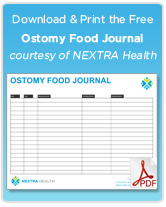The temperature and climate of the region you live in can have a game-changing affect on how you wear your ostomy appliances. Especially useful for traveling to new climates, or for those who live in temperate zones with extreme temperatures each season, an ostomate has to adapt to these new conditions to keep a consistent wear time and maintain the reliability of their ostomy appliances.
Here are some tips for managing your ostomy in warm and cold temperatures. (See sources/references at the bottom for more information on managing an ostomy.)
Hot Weather
Here are some considerations for managing a stoma in hot climates:
1) Perspiration caused by heat gets between the skin and the barrier, which can cause adhesives to break down. If this is a problem with your adhesive, talk with your nurse and seek out something stronger and more reliable. You can also try an antiperspirant or powder around the ostomy location to keep from perspiration from building up.
2) If you have trouble with ostomy appliance leaks because of moisture, you can also try stoma paste or Eakin seals to create a stronger, more reliable seal.
4) Avoid using any Karaya rubber-based ostomy wafers in high heat conditions. This rubber material is soft and conformable, but in hot conditions it can break down and even melt. It’s best to use a synthetic wafer which tends to have a higher heat threshold.
5) The skin is more susceptible to breakdown when it is hot and moist. his includes the area where the ostomy appliance sits, which can form rashes because of the friction of the pouch against the skin combined with heat. An ostomy pouch cover can be work to soften this, and is also recommended for a more comfortable wear. You can typically find ostomy pouch covers in medical supply stores.
6) Due to sweating, it is especially important for Ostomates to drink more fluids to avoid dehydration.
7) Ostomates who exercise and are more active in the summer months will likely want to keep a variety of pouches, including ostomy mini-pouches and stronger, waterproof adhesives that won’t breakdown if you’re running or swimming. You may also prefer to use a Waterproof tape or elastic ostomy belt with a two-piece system to increase wear time and confidence.
Winter and Cold Weather
A dry skin surface is actually the best condition for applying adhesives and ostomy appliances, but excessive dryness on any part of the skin (especially parts covered with adhesives and appliances…) are more susceptible to irritation.
A solution for dry air may be to try a low-cost humidifier indoors to increase the moisture in the air. Use moderation in how much humidity you increase indoors, however, as excess moisture can cause adhesives to loosen, and can also cause issues with mold in the home.
How much humidity is good? Sticking within a range of 30-50% relative humidity (measured with a hygrometer) is a good range to keep skin from getting too dry without overwhelming you or your home.
Do you have more Ostomy tips for ostomy pouches and different climate conditions? Have you dealt with climate conditions that changed the way you think and wear your ostomy appliances? Leave your comments below!











During hot summer months I will sometimes affix a mini pad to the underside of my pouch so the soft cotton pad is on my skin and not the damp sweaty pouch material. Makes me feel dryer!
Thank you so much for this article it’s been a great help to me
I have an ostomy and the weather in our area has been in the mid 40 degrees Celsius for the past 2 weeks. I noticed today while changing my pouch that my stoma was swollen and red with no pain. Could this be caused by excessive heat? I change my pouch (one piece drainable) every 3 – 4 days. I have never experienced this before and I have had an ostomy for 5 years.
I think a lot of ice cold water my stoma seems to be hurting. Is cold good or bad